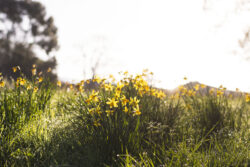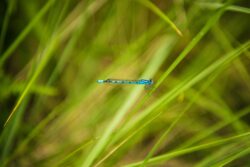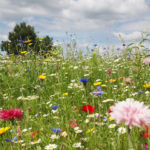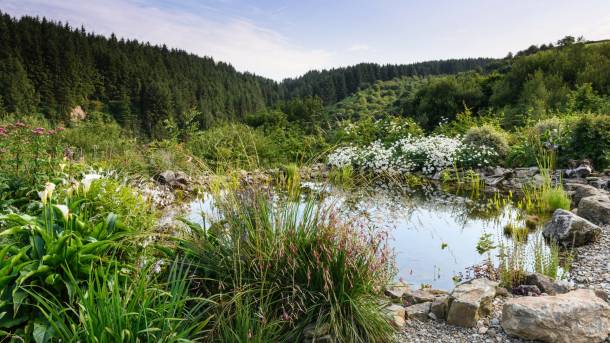Wednesday 26th April 2023
“If you only do one thing this year to improve your garden’s value for nature cut your grass less, or not at all,” says our very own Sarah Mead, creator of the Yeo Valley Organic Garden. “Come on gardeners, would a little less cutting really be such a bad thing?!”

The UK’s climate is perfectly suited to allow grass and the many species of beneficial plants that share our lawns to thrive, but regular cutting deprives essential pollinators of an important food source. According to PlantLife, the British conservation charity behind the No Mow May initiative, allowing your lawn to grow naturally for just a single month can provide enough nectar for ten times the number of bees and other pollinators than a regularly cut lawn. In fact, the average lawn produced enough nectar each day to support 1088 honeybees!

Sarah continues, “Global biodiversity is in decline and our climate is warming. It’s essential that we all recognise the small changes we can make that have a huge collective impact on our environment. Putting your feet up instead of getting the mower out is top of the list!”
The Yeo Valley Organic Garden is supporting PlantLife’s No Mow May challenge again this year and taking part in the charity’s Every Flower Counts campaign. The garden team will be showing, not only throughout the month but also the rest of the year, how less cutting not only improves your lawn’s value for nature but can also provide a fun and cheap way to add more interest to your garden’s design. In the Yeo Valley Organic Garden, 2/3 of the grass will not be mowed at all, leaving only the heavy footfall areas regularly trimmed. In addition, all garden tools, including mowers, are now powered electronically, eliminating the need for fossil fuels and making garden maintenance quieter for both people and wildlife.

You’re only FIVE steps away from a wildlife rich lawn:
-
- Give your lawn an early spring trim to tidy up winter growth and then decide which parts of your lawn you can comfortably allow to grow long in 2022.
- Why not turn over some of your existing lawn to annual meadows instead. At YOG we had two areas of formal lawn that are now a riot of low maintenance colour every year. We took the decision to strip the turf off (composting it down for later use in potting mixes) and sow an annual flower mix instead. The resulting carpet of blooms attracts mases of pollinators and flowers nonstop from June until October, with absolutely no effort from us!
- Alternatively, you could introduce spring bulbs and/or plug plants into existing grass to make the most of your new ‘no mow’ area. Also, if you have lovely early flowers blooming in your grass you certainly won’t be wanting to mow it. Good candidates are crocus tommasinianus, narcissus, cowslips and if you have a wet area camassias – All of which have finished flowering by the end of June when you can mow over them – if you must!
- Commit to only cutting the areas you need to keep short, for example for ease of movement around the garden and children’s ball games
- Try cutting a trail or maze into your longer grass and listen to the buzz of pollinators as you wander through
Sarah’s inspirational, seasonal planting and sympathetic design offer great ideas for how to choose organic principles in your own garden while enjoying year-round colour and form. So why not come and see?
Our garden gates are open to visitors for the season but tickets need to be pre-booked. For information on how to book, click here to head to the Organic Garden page.
Photo credit: Studio Whisk





We’ve kept Guinea pigs and rabbits. We used to place their run on the lawn, moving it every few days. They seemed to chew the grass to a respectable length and fertilise the ground with their pellets. My garden had the most lush grass around. Later when they died,I never used a mower, only hedge shears. I’m sure I looked quite comical to neighbours cutting the lawn with large scissors!
I learnt that natural grazers cows, horses bite the grass not too low and slightly tug at the same time which I presume airates the soil.
This article is great, from a frustrated wannabe bee keeper!
Thankyou…
You have planted a seed! Or at least given me the confidence to actually do what I was thinking off doing….ie let my front lawn grow and populate with wild flowers.. Rather than the pressure felt to conform and have the perfect lawn….Sod the neighbours etc, am thinking of the bee’s etc this year / now! 🙂
Just gotta source / get some seeds now!
I think this is a great idea if you have a suitable area. My only reservation is that if you are in a rural location there can be a problem with ticks and lyme disease.
I’ve been leaving more and more grass uncut each for for several years now. Even if the grass grows tall and blocks out some of the wild flowers, the long grasses look lovely with their great variety of seed heads (which make good winter feed for birds) and the grasses look lovely wavering in the summer breezes. I wonder how much frequent mowing also contributes to global warming? (10m, 20million mowers – more?, every week, more often? – throughout the summer?
As industrial farming has led to the loss of bio-diversity, gardens can become a refuge, avoid lawn treatments that contain weed killers and respect the creatures that share your space.
QUOTING FROM YOUR ARTICLE “We suggest equal amounts of ox eye daisy, red clover and field scabious.”… it would be excellent if you had different quantitates packaged and available to buy from you, or suggest other sources, bearing in mind, I guess, that seeds need to be appropriate/ specific to the area and its soil etc.
yes I will try this. My Husband passed away recently and he was always tending the lawn but I think sowing seeds will be less lawn for me to cut
Dear Sarah,
I have been experimenting with my ‘lawn’ for a number of years. Initially I wanted to create a traditional meadow with ‘rides’ for access. The first summer I didn’t cut the grass(es) at all and was surprised at the variety of grasses and sedges, as well as the plenitude of butterflies and moths (I was recording nightly with a light box). There weren’t very many wild flowers to be seen, but I did find a couple of bee orchids and some pyramidal orchids which probably hadn’t been able to flower for years on the ‘golf course’ lawn that had been.
All seemed fine until the autumn, when I thought it best to cut the ‘hay’ to use as mulch under my fruit trees and on a path elsewhere. My mower couldn’t cope; a scythe had difficulty with the rain-matted grasses, and I didn’t have access to an Allen mower with cutter-bar. I ended up spending three or four days cutting it, on my knees, with a hook and sickle (I actually did this two years running!).
What I found was numerous large ant hills, tussocks of the more dominant grasses/sedges, and a very rough surface once I had finished and run the mower over it. Not very pleasing!
Thereafter I mowed it infrequently whenever it reached the mower’s limited capabilities.
Last year I left about a quarter of it to grow from May until August, and then cut that area, once again, with my sickle. There must be better ways to achieve a manageable lawn. I can understand why people object to just letting a lawn go!
So what do you do later in the season when the grass and flowers die back? We tried this some years ago and it was really difficult almost impossible in fact to mow it needed strimming, or do you just leave it to remain rough? We found huge numbers of slugs living in there and popping out at night to eat our veg and flowers. We have a reasonable size lawn, but surely this is no being suggested for small lawns?
Quite right too, I have never understood lawn cutting until recently when I discovered that manicured lawns in country parks were the result of cutting for feed for horses.